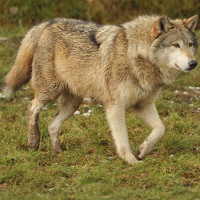 |
Eastern Wolf |
|
He is a wild animal |
Origin |
Canada | |
Translation |
Francis Vandersteen |
| The possession of this animal is not authorized Royal Decree establishing the list of mammals not kept for production purposes that may be kept (M.B. 24.08.2009) |
| The Eastern Wolf (Canis lycaon) is a carnivorous mammal of the Canidae family found in North America. Genetic studies carried out in the 21st century confirm that it is a New World species in its own right, and not a subspecies (Canis lupus lycaon) of the Grey Wolf (Canis lupus) as was once accepted. Populations of this wolf are found mainly in Canada, particularly in the protected area of Algonquin Provincial Park. Canis lycaon should not be confused with another very different species of Canidae, the wild dog (Lycaon pictus). Research carried out in Canada in the 21st century has identified two types of wolf in this territory: the Ontario type, confined mainly to boreal forests and thought to be Canis lupus, and the Algonquin type, Canis lycaon, also found in temperate deciduous forests. The eastern wolf mainly occupies the protected area of Algonquin Provincial Park, which is bordered to the south by an area inhabited by hybrid coyotes (C. lycaon x C. latrans), known in English as "Tweed wolf". They are also thought to occur in Minnesota and Manitoba. In the past, these species may have arrived further afield in the USA, but after the arrival of Europeans, these wolves were heavily persecuted in the country. In Canada, the exact number of eastern wolves is unknown. In Algonquin, wolves often travel outside park boundaries, entering farmlands where some are killed. Of all wolf deaths recorded from 1988 to 1999, a minimum of 66% were caused by humans. The park's external shooting boundaries were the main cause of death for chip-equipped wolves in Algonquin Park. A wolf tagged in July 1992 was spotted in October in Gatineau Park, 170 km from Algonquin. By mid-December, it had returned to Algonquin, then, in March 1993, the severed head of this wolf was found nailed to a telephone pole in Round Lake by a wolf-hating man. The Canis lycaon species, in fact, forms a metapopulation. This metapopulation retains a high degree of variability and adaptation, enabling it to withstand competition from man better than the gray wolf, whose populations are declining. In contrast to their gray cousins, populations with predominantly Canis lycaon genetic material, or those of coyotes with which they have interbred, tend to thrive. It is difficult to estimate the number of Canis lycaon living in the upper Great Lakes region, as the different species of canid readily mix and interbreed. Coyotes and Eastern wolves are so similar that a hunting ban has been introduced for all wolves in Canada, as well as for coyotes, to prevent accidental deaths, since gray wolves, Eastern wolves and coyotes live side by side on Canadian territory. |






 English (United Kingdom)
English (United Kingdom)